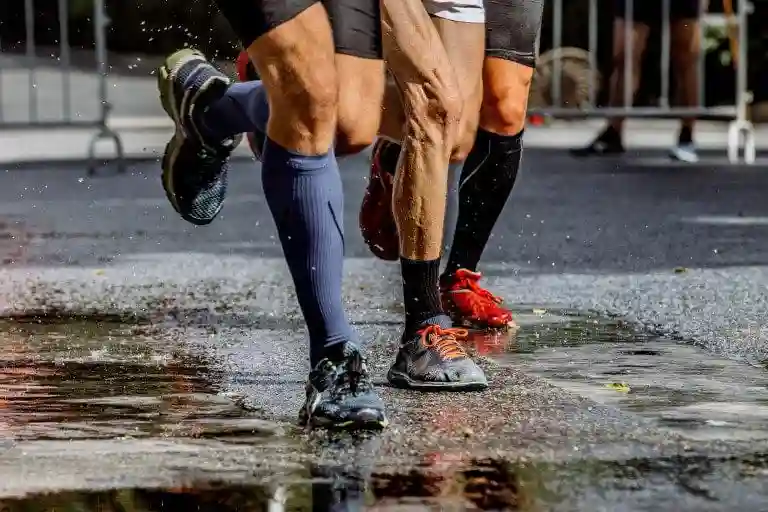
Every marathon step matters. For many runners, small issues — moisture, blisters, tired legs — decide whether they finish strong or limp to the line. Brands that specify the right sock features solve those problems for customers. They also reduce returns and build repeat buyers.
Below, I break down seven must-have features. Each section is short and practical. Read the quick checklist, then see how our factory turns specs into production-ready socks.
Quick checklist — what top marathon socks include
- Moisture-wicking, quick-dry fabrics
- Targeted cushioning (heel, toe, sole)
- Seamless toe construction
- Graduated or light compression is useful
- Antimicrobial / anti-odor treatments
- Ergonomic fit with arch support
- Reinforced durability and ankle protection
Why Choosing the Right Running Socks Matters
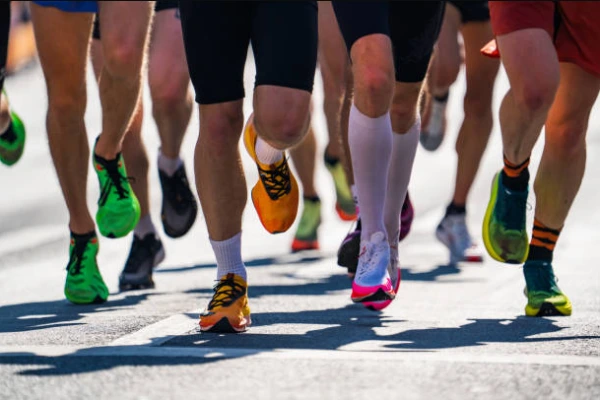
Every step in a marathon counts. Yet, the secret to better performance may not lie in your shoes alone—it can be in your socks. Discomfort, blisters, and fatigue often come from overlooked details. Quality socks help keep feet dry, comfortable, and well-supported, making a noticeable difference over long distances. For brands, offering these specialized products shows a commitment to both quality and innovation. This post reveals seven key features that set apart top-tier marathon running socks. Learn how each feature boosts comfort, prevents common foot issues, and builds lasting customer trust.
Feature 1: Moisture-wicking fabrics that prevent blisters (materials & specs)
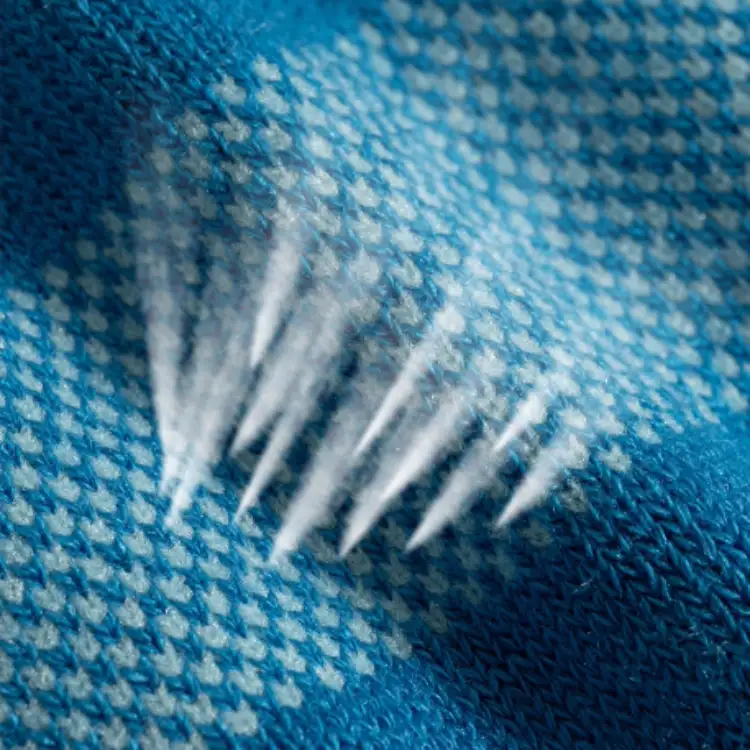
Wet feet raise friction. Friction creates hot spots that can develop into blisters. Fast-wicking yarns move sweat away from the skin and speed evaporation. That keeps feet cooler and more comfortable over long distances.
Practical specs brands can require:
- Measurable claims (examples): “sweat transport rate: X g/m²/24h” or “dry time < Y minutes.”
Include knit gauge and yarn denier so buyers know expected dry time and feel. - Material: polyester/polyamide blends for fast dry; merino blends for temperature balance and odor control.
- Construction: open knit or mesh zones for ventilation.
Feature 2: Targeted cushioning where it matters

Cushioning reduces impact and lowers foot fatigue. But too much padding changes the shoe fit. Offer two clear variants: a light “race” model and a moderate “training” model. That meets both runners who want ground feel and those who need extra protection.
Design bullets for production:
- Knit structure: zonal terry or engineered pile for durability and compression compatibility.
- Cushion zones: heel, under-metatarsal, toe.
- Thickness: specify mm or knit weight (e.g., light 1.5 mm/training 3.5 mm).
Feature 3: Light graduated compression for training and recovery

Graduated compression can ease leg fatigue and aid recovery. For marathon use, keep claims performance-focused and avoid medical language unless clinically tested. Specify compression ranges and construction method.
Factory-ready parameters:
- Testing: provide compression mapping and a compression gauge report for samples.
- Compression ranges: gentle 8–15 mmHg for recovery; 15–20 mmHg for sport-use (label clearly).
- Method: knitted graduated zones vs. uniform elastic band.
Feature 4: Seamless toe construction to prevent hot spots
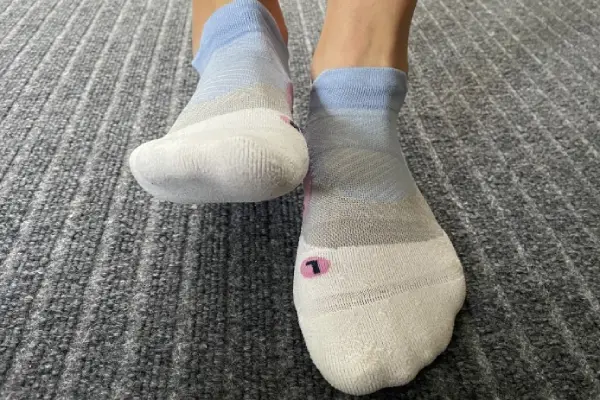
Toe seams produce concentrated friction after long miles. Seamless toe finishes remove that risk and improve comfort inside the shoe. For many runners, this is a must-have.
What to ask for:
- QA: include wear tests (10–20 mile field test) in sampling.
- Finish type: flat-link or hand-linked seamless toe.
- Bulk: measure toe-seam thickness to ensure no added pressure inside tight race shoes.
Feature 5: Anti-odor and antimicrobial treatments
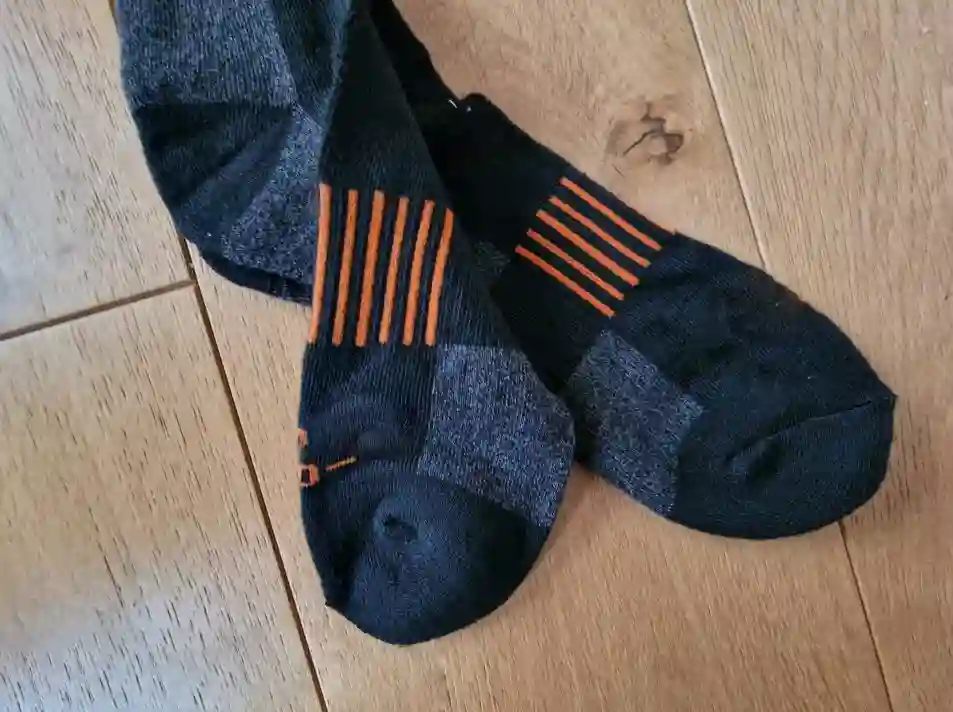
Effective anti-odor materials include fibers infused with silver or copper ions, bamboo charcoal, and merino wool. These fabrics prevent bacterial growth, controlling odors naturally. Merino wool, in particular, combines odor resistance with breathability, making it an appealing choice for endurance running gear.
Options and checks:
- Fibers: merino for natural odor resistance; recycled polyester blends for sustainability.
- Treatments: silver or copper ion infusion, or activated charcoal blends.
- Compliance: request safety and environmental data for treatments and list any certifications.
Highlighting these features helps brands attract marathoners who prioritize comfort and freshness, encouraging repeat purchases and customer satisfaction.
Feature 6: Ergonomic fit: arch support and secure hold
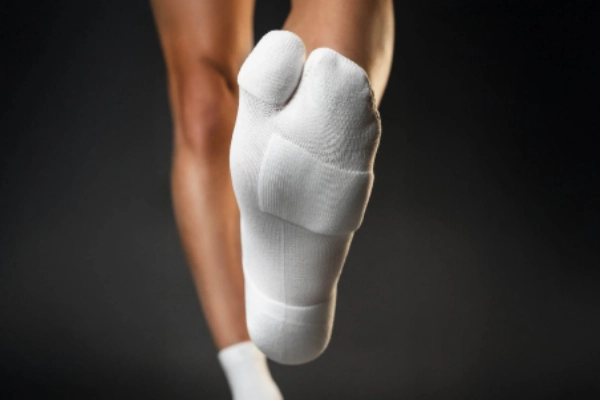
A slipping sock creates friction. A sock that binds reduces comfort. Ergonomic shaping keeps the sock stable while preserving circulation. Clear sizing and fit specs cut down size-related returns.
Fit specs to include:
- Heights: provide no-show, ankle, and crew versions with exact rise in cm.
- Arch band: defined elastic band and stretch percentage.
- Sizing: foot length + circumference table per SKU.
Feature 7: Durability and ankle protection

Marathon training wears out socks. Reinforced areas and stable knit retain shape and performance over many runs. For trail or uneven terrain, a slightly higher cut and added ankle padding help protect against debris and impact.
Durability details:
- Wear tests: abrasion cycles and wash retention benchmarks.
- Reinforcement: double-knit heel/toe, high-tenacity yarn blends.
- Elastic content: % Lycra®/Elastane for shape retention.
How socks and shoes should be paired
Shoe type changes the ideal sock. Minimalist shoes pair best with thin race socks for ground feel. Cushioned shoes match well with moderate-cushion socks for extra protection. Always test the sock + shoe combo on long runs before finalizing specs. Add simple pairing notes on product pages to help end customers choose.
Socks for different running scenarios

Road & marathon
Lightweight, fast-drying yarns and seamless toe finishes are priorities. Aim for low bulk and targeted cushioning so the sock does not change the shoe fit during long races.
Spec tips: race model — light cushion (1–1.8 mm), open knit ventilation; seamless toe required.
Trail & off-road
Durability and protection matter more than minimal weight. Use reinforced heel/toe, higher cut options to block debris, and slightly thicker cushioning for uneven terrain.
Spec tips: trail model — reinforced double-knit toe, mid-cut or crew height, abrasion-tested yarn blends.
Recovery & training
Comfort and circulation support take precedence. Gentle graduated compression and moderate cushioning speed recovery, and make long training days more comfortable.
Spec tips: recovery model — 8–15 mmHg graduated compression, moderate cushion, breathable but denser knit for durability.
FAQS
What socks do marathon runners actually wear — race day vs training?
On race day runners usually pick thin, low-bulk, fast-drying socks with seamless toes to minimize hot spots and keep shoe fit intact. For training, runners prefer slightly thicker, more durable socks with targeted cushioning to withstand repeated miles. Recommend offering two SKUs — Race (1–1.8 mm cushioning) and Training (2.5–4 mm cushioning) — and list knit weight and thickness on the tech sheet.
Are seamless toe socks noticeably better for blister prevention?
Yes — seamless toe construction removes a frequent friction point and significantly reduces toe hot-spots on long runs. Require field validation during sampling (10–20 mile runs) to compare hot-spot incidence between seamless and standard-toe samples before final approval.
Can compression socks be worn during a marathon — and what level is suitable?
Light graduated compression (about 8–15 mmHg) is commonly used for endurance runs and recovery and can help reduce fatigue without making medical claims. For higher clinical ranges (>20 mmHg), label carefully and use clinical evidence; always request a compression map and gauge test with samples.
Which materials give the best balance of dry time, durability, and odor control?
Synthetic fibers (polyester, polyamide/nylon) dry fastest and handle abrasion well, while merino wool adds natural odor resistance and temperature regulation and works best in blends. List yarn denier and fiber percentages on the tech sheet so buyers can predict dry time, hand-feel, and wash performance.
How should brands test socks before full production?
Run a minimum test matrix: 5–10 testers for 10–20 mile field runs, 30 wash cycles for durability and cushion retention, and supplier abrasion tests (e.g., 3k–5k cycles). Track hot-spot reports, cuff slip, cushion retention, and compression retention; use these metrics to accept samples or adjust knit and yarn specs.
Conclusion

The best marathon running socks deliver balanced compression, moisture management, and long-lasting comfort for every distance. For brands and retailers, working with a reliable sock manufacturer ensures consistent quality and fewer end-customer complaints.
Partner with Max Hosiery — a trusted compression and performance sock factory ready to customize marathon running socks to your specifications. Contact us to discuss your next collection or request development samples today.
